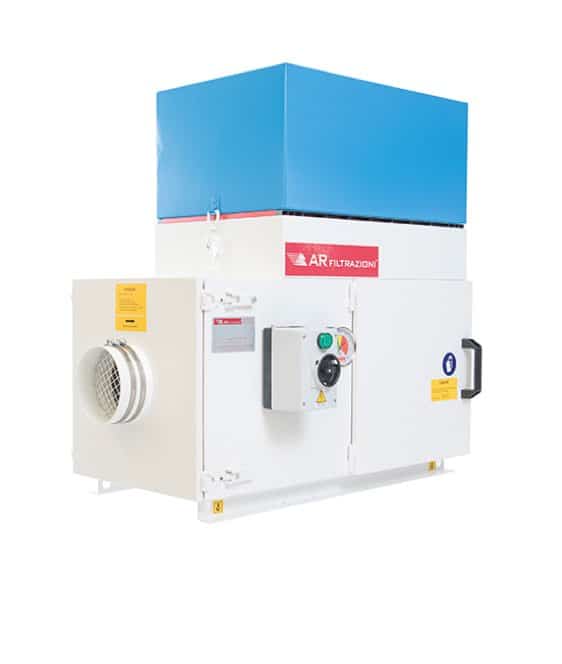ELECTROMAGNETIC INDUCTION HARDENING
AR FILTRAZIONI | ELECTROMAGNETIC INDUCTION HARDENING
AR Filtration and filtration of oil mists in induction heat treatments
Thanks to its particular efficiency, the induction heat treatment is used on a wide range of applications. Very high temperatures from the treated piece and the consequent use of coolant liquids, produce oil mists and fumes.
AR Filtrazioni has ideal exhaust system and mist collectors to eliminate the problem of oil pollutants and fumes, produced during electromagnetic induction hardening.
The mist collector suitable for electromagnetic induction heating systems
Among the heat treatments of steel or cast iron, you can list different types of plants for induction heating for tempering, welding, molding, hardening under press, brazing, annealing, forging, casting.
Particularly relevant is induction hardening, used to increase the surface hardness of wearintensive materials, improving strength and fatigue limit, significantly lengthening their life cycle.
Induction hardening: technical details
The heat treatment of the induction hardening consists in a rapid heating of the area to be reinforced, at a temperature above the point of austenitization of the Ac3 steel (900 ° – 950 °), in maintaining this temperature for a suitable time of material homogenization and in the subsequent rapid cooling (with jets of water or other coolants), in order to allow the transformation.
During the cooling phase, the coolant evaporation/combustion generates fumes and odors.
The steel heating temperature and its spent time at same temperature, have to allow to the starting structure to become completely austenitic without exceeding critical levels.
Therefore the cooling rate must be particularly high and controlled, because exceeded temperatures could cause unwanted and unprofitable transformations.
During the induction hardening treatment, “induced” (as the name implies) currents in the body to be headed, produce heat in presence of an alternating magnetic field.

Multi-station induction hardening and tempering for inner and outer hub bearings
Induction hardening machines – application fields
Due to the advantages it offers, induction hardening is suitable for a large range of mechanical products and different industrial sectors:
– Automotive: crankshafts / camshafts, parts of transmission and steering, drawing and cutting dies (obtaining doors, hoods, panels, etc.), cutting blades, nuts and bolts included.
– Railway: several components of rolling-stock, exchange-boxes, various linkages.
– Naval: transmission shafts, gears, parts for military applications.
– Oil & Gas: sliding shafts, gear wheels, pinions typically used in off-shore platforms.
– Aeronautics: pins, shafts, gears.
– Metallurgical: rolling mill cylinders, rolls, back-up rolls, toothed crowns, worms.
– Various sectors (sheet metal / paper / chains / machine tools / food): special bearings, cylinders for levelers, spiral rollers, embossed rollers, plates, bushings, cams, screws, linear guides, wheels for cranes, columns for presses, etc .
Large bearings hardening and stress relieving system
Multi-station induction hardening and tempering for inner and outer hub bearings.

The problem of exhalations fumes and odours not held in mechanical workshops.
The volatility of polluting particles such as industrial fumes, exhalations and odours creates various problems for metalworking companies, operators and machine tools.
First of all, they negatively affect the health of the air and the health and hygiene conditions of the operators, in particular at the respiratory level, since the particles smaller than 0.3 microns can reach the pulmonary alveoli, compromising the respiratory tract. Not only that, in contact with the epidermis, they create skin irritations, dermatitis and redness.
From production side, pollution in the workshops considerably reduces the productivity of the plant and in particular the efficiency of the induction hardening machines, since the stratification of pollutants invalidates the precision and tolerance of the measure, with the onerous consequence of having to increase maintenance on the most delicate components.
Without forgetting any possible fines deriving from current regulations, which impose a concentration limit for oil mists and fumes in the workplace.
The best system for the abatement of exhalations,fumes and odours is an activated carbon filter preceded by a very high efficiency pre-filtration stage H13.
The pollution elements SOV and COV, thanks to this depuration technology, go through a filtering stage of active carbon.
Thanks to its porosity, activated carbon absorbs and hold most of the organic substances; for this reason it is used in all industrial filters for the removal of solvents and odors in many sectors and applications.
Thanks to a mechanical prefiltration, the efficiency and durability of the last active carbon cell is longer.
THE AIR CLEANER FOR YOUR NEEDS
CHOOSE YOUR RIGHT SOLUTION
Select by
MACHINERY
Choose the processing type and consequently the desired machine. You can choose the ideal filtration unit for your machine.
Learn how to reduce oil consumption, save on conditioning and reduce CO2 emissions.
Fill out the form and our calculation system will immediately quantify the savings you can get and send you the results by email.

















